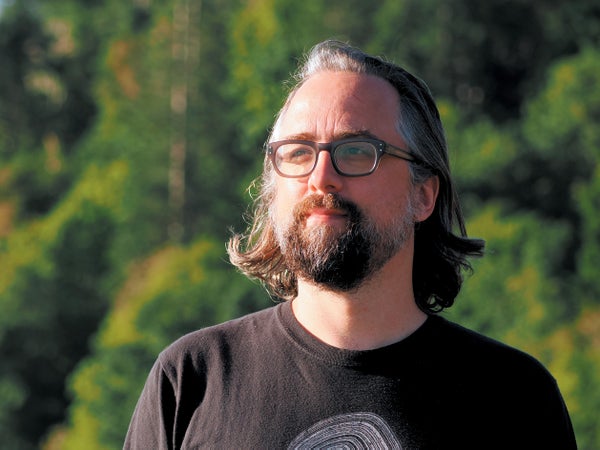September 17, 2024
4 min read
Contributors to Scientific American’s October 2024 Issue
Writers, artists, photographers and researchers share the stories behind the stories

Jer Thorp
Fate of the Hybrid Chickadees
During the first web boom, Jer Thorp got a job writing code—something he didn’t really know how to do. He practiced by making art with software programs and in the process developed a passion for turning numbers into engaging visualizations. As a data artist, Thorp enjoys bringing information off the page or screen and into people’s lives by creating physical sculptures and installations, ones that capture immigration statistics or melting glaciers.
Recently, though, Thorp’s art has been all about birds. Like many people, he became an avid birder during the COVID lockdown. Even living in Brooklyn, N.Y., “there’s not really a moment where you cannot find a bird,” he says. For this issue’s feature story about hybrid chickadees by writer Rebecca Heisman, Thorp mapped the hybrids’ shifting range. He sees these two loves—of birding and of data—as fundamentally linked; he now teaches a course on them and is writing a book called We Were Out Counting Birds. “Birders are fundamentally data collectors,” he says. Even those who don’t add their observations to community science repositories are still keen observers of behavioral data. Birding, he says, “helps you learn how to notice” the natural world.
On supporting science journalism
If you’re enjoying this article, consider supporting our award-winning journalism by subscribing. By purchasing a subscription you are helping to ensure the future of impactful stories about the discoveries and ideas shaping our world today.
Elizabeth Svoboda
The Empathy Incentive
Over the course of her career as a science journalist, Elizabeth Svoboda has grappled with a big question: “Why,” she says, “do we follow our best instincts in some situations and follow our worst instincts in others?” Svoboda explored this question in 2013 in her first book, What Makes a Hero?, which is about why some people readily make sacrifices for others. And for her feature story in this month’s issue, she dug into the science of empathy. As an idea, empathy “sounds great,” she says, but it can be difficult to put into practice, especially when engaging with people who disagree with you in fundamental ways. “My instinct is just to get defensive and anchored in my view—just defending it at all costs,” Svoboda says. She wanted to know: “Are there ways to not just teach empathy but motivate it?”
In reporting the story, she found her answer: people are inclined toward empathy when they’re surrounded by an empathetic community. She traveled from her home in the California Bay Area to an elementary school in Los Angeles where parents and teachers are participating in a program to intentionally foster empathy. “It’s a living experiment,” she says—one that felt very different from her more Lord of the Flies–style experience of elementary school decades ago. “The environment is changing, and that really gives me a lot of hope.”
Roxanne Scott
Living with Sickle Cell Disease
Roxanne Scott was a social worker in her first career and a teacher in her second. She taught in Costa Rica, Mexico and China. Inspired by the African diaspora that she encountered in each country, she started a travel blog about the global Black experience, which inspired her third and current career as a journalist.
Scott lived in Ghana for a year during her transition to journalism, and because of frequent power blackouts, she consumed news mostly by radio. That’s how she became a radio reporter focused on how climate change impacts immigrant communities. In 2021 Scott moved to Queens, N.Y., right before Hurricane Ida caused deadly flooding in New York City that especially affected marginalized groups. She has since immersed herself in reporting on ongoing flooding in these neighborhoods.
For this special report, Scott asked people whose lives have been upended by sickle cell disease to tell their stories in their own words. Gathering first-person perspectives “was right up my alley as a radio reporter,” she says, and is especially important for understanding what it is like to live with the condition, which causes excruciating pain that is often overlooked because of systemic racism. Those who shared their stories “were open books,” Scott says. “I think they really wanted their voices heard.”
Kenn Brown and Chris Wren
Back to the Moon
In the 1990s Kenn Brown and Chris Wren met while working at an animation studio in Vancouver. They were both in the background department, Brown using computers and Wren using brushes and pencils. Their skills have always complemented one another, and today they are partners in business and in life, splitting their time between Canada and Nayarit, Mexico. Since 2001 their editorial illustrations—including dozens of covers—have brought a futuristic flair to Scientific American. Creating art at the “cutting edge” of science and technology “has actually been a great way to keep educating myself constantly,” Wren says. “You must stay on your toes,” Brown adds.
This month’s cover story by magazine contributor Sarah Scoles on the Artemis II mission to the moon brought them back to a long-standing, shared passion for space exploration. They grew up on the technological optimism of the space race and the cultural optimism of Star Trek: The Next Generation. In their art, they enjoy exploring how humanity will change space—and how being in space will change humanity. “We’re kind of blessed that our hobby is our living,” Wren says. “A lot of the assignments that we’ve gotten over the past 23 years are things that we would have done anyway.”

